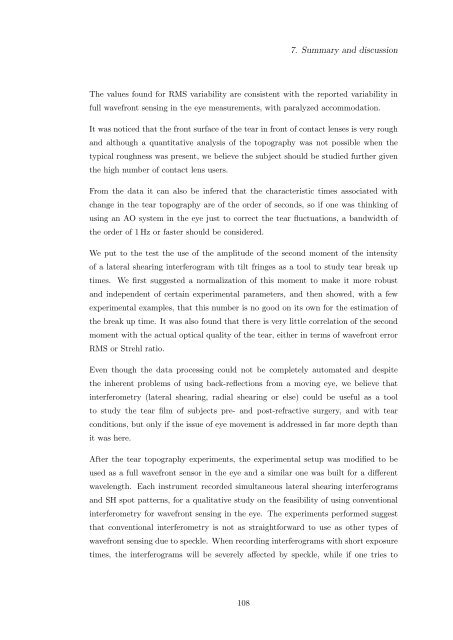Alfredo Dubra's PhD thesis - Imperial College London
Alfredo Dubra's PhD thesis - Imperial College London
Alfredo Dubra's PhD thesis - Imperial College London
You also want an ePaper? Increase the reach of your titles
YUMPU automatically turns print PDFs into web optimized ePapers that Google loves.
7. Summary and discussion<br />
The values found for RMS variability are consistent with the reported variability in<br />
full wavefront sensing in the eye measurements, with paralyzed accommodation.<br />
It was noticed that the front surface of the tear in front of contact lenses is very rough<br />
and although a quantitative analysis of the topography was not possible when the<br />
typical roughness was present, we believe the subject should be studied further given<br />
the high number of contact lens users.<br />
From the data it can also be infered that the characteristic times associated with<br />
change in the tear topography are of the order of seconds, so if one was thinking of<br />
using an AO system in the eye just to correct the tear fluctuations, a bandwidth of<br />
the order of 1 Hz or faster should be considered.<br />
We put to the test the use of the amplitude of the second moment of the intensity<br />
of a lateral shearing interferogram with tilt fringes as a tool to study tear break up<br />
times. We first suggested a normalization of this moment to make it more robust<br />
and independent of certain experimental parameters, and then showed, with a few<br />
experimental examples, that this number is no good on its own for the estimation of<br />
the break up time. It was also found that there is very little correlation of the second<br />
moment with the actual optical quality of the tear, either in terms of wavefront error<br />
RMS or Strehl ratio.<br />
Even though the data processing could not be completely automated and despite<br />
the inherent problems of using back-reflections from a moving eye, we believe that<br />
interferometry (lateral shearing, radial shearing or else) could be useful as a tool<br />
to study the tear film of subjects pre- and post-refractive surgery, and with tear<br />
conditions, but only if the issue of eye movement is addressed in far more depth than<br />
it was here.<br />
After the tear topography experiments, the experimental setup was modified to be<br />
used as a full wavefront sensor in the eye and a similar one was built for a different<br />
wavelength. Each instrument recorded simultaneous lateral shearing interferograms<br />
and SH spot patterns, for a qualitative study on the feasibility of using conventional<br />
interferometry for wavefront sensing in the eye. The experiments performed suggest<br />
that conventional interferometry is not as straightforward to use as other types of<br />
wavefront sensing due to speckle. When recording interferograms with short exposure<br />
times, the interferograms will be severely affected by speckle, while if one tries to<br />
108

















